Do you have a question about the Panasonic KX-TDA50G and is the answer not in the manual?
Describes the purpose and structure of the Feature Manual, outlining its sections and references.
Lists other related manuals and sections referenced within the Feature Manual for further information.
Provides essential safety information to prevent danger to users, people, and property.
Details features supporting private networking, such as TIE Line Service and QSIG Support.
Highlights features for small call centers like Queuing, Log-in/Log-out, and VIP Call.
Describes how computers connect to the PBX for advanced features like caller ID display and CTI applications.
Extension users can prepare a brief text message displayed to other users when they are called, explaining absence.
An account code identifies outgoing CO line calls for accounting and billing purposes, appended to SMDR records.
Automatically selects different telephone carriers for calls to different areas to reduce costs.
Distinguishes fax calls on DISA lines and automatically transfers them to preprogrammed destinations.
Allows PT users to listen to background music (BGM) through the built-in speaker while on-hook and idle.
Receives Caller ID information (name/number) from CO lines, displays it, and logs it for call management.
Allows extension users to place calls on hold, with options for regular or exclusive retrieval.
Enables transferring calls to another extension or an outside party, with or without announcement.
Informs a busy extension user of another incoming call, allowing them to answer or place the current call on hold.
Provides three methods to access a CO line: Idle Line Access, Trunk Group Access, and S-CO Line Access.
Allows establishing conference calls by adding parties to existing conversations, supporting three-party through eight-party calls.
Controls extension user behavior and privileges by assigning them to a Class of Service (COS).
Connects computers to the PBX for advanced features like caller ID display and CTI applications.
Protects communication from signals like Call Waiting, Hold Recall, and Executive Busy Override for secure data transmission.
Directs calls on DID lines to preprogrammed destinations based on the dialed DID number.
Directs incoming CO line calls to preprogrammed destinations based on the CO line carrying the call.
Allows outside callers to access PBX features as an SLT extension user via a DISA floating extension number.
Proprietary telephones (PTs) display call information like caller ID, extension status, and dialed numbers.
Prevents calls from arriving at an extension, redirecting them to another extension or operator.
Allows extension users to perform features outside the PBX, such as telephone company transfer services.
Enables dialing preprogrammed emergency numbers regardless of extension restrictions.
Allows an extension user to interrupt an existing call to establish a three-party conference call.
Allows an extension user to change the Toll Restriction (TRS) level to prevent inappropriate CO line calls.
Assigns a personal identification number (PIN) for features like LCS, Walking COS, and remote access.
Allows the PBX to control external devices like alarms by turning external device relays on and off.
Connects external sensing devices (alarms, smoke detectors) to the PBX, triggering calls to a preset destination.
Describes the various feature buttons and Line Access buttons found on Proprietary Telephones (PTs) and DSS Consoles.
Allows disconnecting a call and originating another without hanging up, or sending a flash/recall signal to external features.
Enables customization of flexible buttons and programmable feature (PF) buttons on PTs, Key Modules, and PSs for various functions.
Defines numbering plans for extension numbers and feature numbers, allowing customization for ease of use.
Assigns virtual extension numbers to resources for easy access, used for incoming calls or as destinations.
Forwards calls to preset destinations based on call type (All Calls, Busy, No Answer, Busy/No Answer).
This PBX supports various types of groups: Trunk Group, Extension User Group, Call Pickup Group, Paging Group, Idle Extension Hunting Group, Incoming Call Distribution Group, VM Group, PS Ring Group.
Allows PT users to talk to callers without lifting the handset by establishing a hands-free conversation.
Supports headset-compatible PTs for hands-free talking and operating without lifting the handset.
Provides features supporting hotel environments, like Room Status Control and Remote Wake-up Call.
Allows a PBX installed behind a host PBX to access the telephone company through the host PBX.
Allows an extension user to make an outgoing call by simply going off-hook after storing a number.
Covers features for Incoming Call Distribution groups, including distribution methods, queuing, VIP calls, and overflow.
Redirects incoming calls to an idle member of the same hunting group when the called extension is busy or in DND mode.
Describes how CO lines function as public or private lines, and features available based on networking type.
Redirects calls to a preprogrammed destination when the original destination cannot answer.
Allows an extension user to call another extension user.
Restricts internal calls based on the Class of Service (COS) assigned to the caller and called party.
Supports IP proprietary telephones (IP-PTs) connected via LAN, functioning like normal PTs.
Describes ISDN features for digital voice, data, and image transmission over ISDN lines.
Explains the meaning of various light patterns on Message/Ringer Lamp and buttons to indicate line status.
Allows PT users to select the method for answering incoming calls from three line preferences.
Allows PT users to select the preferred method for seizing a line when going off-hook.
Provides information on PBX errors displayed on the PT's System Alarm button.
Details features accessible by manager extensions, including password management, remote settings, and OGM recording.
Allows users to store and dial frequently used numbers easily via One-touch Dialing, Speed Dialing, and Last Number Redial.
Notifies extension users of missed calls or waiting messages via a lit button or lamp.
Allows playing music or tones to parties on hold, with options for internal, external, or tone audio sources.
Enables users to disable their microphone during a conversation for private consultation.
Allows PT users to let others listen to their conversation through the built-in speaker.
Enables manager extensions to record outgoing messages for features like DISA, Queuing, and Timed Reminder.
Allows an extension user to talk with a busy extension through the built-in speaker and microphone.
Enables users to make calls or access features with a single button press by storing numbers or feature codes.
Allows any extension or ICD group to be designated as a PBX operator or tenant operator.
Allows users to make voice announcements to multiple people simultaneously via PT speakers or external pagers.
Enables connecting multiple telephones to a single extension port, increasing the number of connected telephones.
Requires system passwords for accessing programming functions to maintain security.
Inserts a programmed pause time between dialed digits for accessing features or specific codes.
Integrates PBX features with PCs for advanced call control, contact management, and voice memos.
Allows detailed programming, diagnosis, and data management of the PBX using Maintenance Console software via PC.
Facilitates boss-secretary communication by allowing secretaries to monitor and manage the boss's calls.
Automatically connects SLTs to specific CO lines for making calls during a power failure.
Allows users to check and correct a number on-hook before initiating the call off-hook.
Enables selecting preprogrammed messages for output on SMDR, useful for employee work records.
Allows suspending Automatic Privacy for CO line calls to establish a three-party call.
Supports private network communications using TIE lines and QSIG/VoIP protocols for inter-PBX connectivity.
Allows multiple PBXs in a network to share a VPS for voice mail services, including message waiting notifications.
Enables monitoring extension status and making/transferring calls with one touch across networked PBXs.
Allows ICD groups to include destinations at other PBXs in a private network, assigning virtual PSs as members.
Enables a PS to be registered to multiple PBXs, allowing calls to ring simultaneously across the network.
Provides enhanced PBX features in a private network using ISDN (Q.931) and QSIG protocols.
Allows users to receive callback ringing when a busy called party on the QSIG network becomes free.
Forwards calls to a destination extension in another PBX within the QSIG network.
Sends caller/answered party's number and name to the QSIG network for display on the called party's telephone.
Transfers calls to a destination extension in another PBX within the QSIG network.
Connects PBXs via a private IP network, sending voice signals as IP packets (VoIP).
Allows Panasonic portable stations (PSs) to access PBX features wirelessly, with registration and PIN security.
Enables PS users to make calls or access PBX features using stored information.
Customizes PS buttons to provide access to PBX features, similar to PT flexible buttons.
Allows multiple PSs to receive group calls simultaneously using a single cell station (CS) channel.
Allows users to customize PBX or extension settings via proprietary telephone (PT) using Personal, System, or Manager Programming.
Enables easy call access by storing numbers (extension, telephone, feature) for one-touch dialing.
Guides users through initial PBX parameter programming using Maintenance Console software.
Automatically saves the last dialed external number for redialing and logs outgoing CO calls.
Allows selection of different ring tone patterns for incoming calls based on type and feature.
Enables hotel operators to view and change the Check-in/Check-out/Cleaned-up status of guest room extensions.
Automatically logs detailed call information per extension, including CO line calls, intercom calls, and log-in/log-out status.
Assigns a code required to use specific telephone carriers for CO line calls when ARS is not used.
Allows extension users to store and make calls using abbreviated dialing via Personal Speed Dialing.
Stores frequently dialed numbers in the PBX as System Speed Dialing numbers for abbreviated dialing.
Provides answering machine features by installing an optional SVM/ESVM card, allowing personal greetings and message storage.
Carries twenty-four 64 kbps voice channels at 1.5 Mbps, usable as public or private lines.
Sends a ring tone through an external pager when an incoming call is received, allowing any extension user to answer.
Provides cost-effective PBX services to different offices or companies in the same building using a single PBX.
Allows presetting extensions to ring at specific times for wake-up calls or reminders.
Determines how PBX features function based on different times of day (day, lunch, break, night) via Time Tables.
Prohibits extension users from making certain CO line calls based on Class of Service (COS) assignments.
Allows uploading software from a PC to upgrade PBX functions, system data, and language data.
Allows users to enter verification codes to change Toll Restriction (TRS) levels or identify calls for accounting.
Assigns temporary extension numbers for portable stations (PSs) to access PBX features remotely.
Groups extension ports to form a VM group, acting as a destination for redirected or incoming calls.
Integrates Panasonic VPS with DPT ports for features like automatic mailbox creation and call redirection.
Enables PBX and VPS to exchange commands using DTMF signals for answering service modes and status.
Allows users to make calls using another extension's Class of Service (COS) and TRS level via PIN entry.
Enables trading extension settings (number, COS, memory) with another extension.
Allows an extension user to speak to a busy extension through the handset without the other party hearing.
Allows a portable station (PS) to be used in parallel with a wired telephone, sharing the extension number and settings.
Provides a table detailing the maximum capacity of various PBX features and resources across different models.
Lists features that are available only for specific PBX models (KX-TDA50, KX-TDA100/200, KX-TDA600).
Illustrates default tone patterns for confirmation, dial, busy, reorder, ringback, and DND tones.
Lists new and changed contents for different software file versions.
Describes the purpose and structure of the Feature Manual, outlining its sections and references.
Lists other related manuals and sections referenced within the Feature Manual for further information.
Provides essential safety information to prevent danger to users, people, and property.
Details features supporting private networking, such as TIE Line Service and QSIG Support.
Highlights features for small call centers like Queuing, Log-in/Log-out, and VIP Call.
Describes how computers connect to the PBX for advanced features like caller ID display and CTI applications.
Extension users can prepare a brief text message displayed to other users when they are called, explaining absence.
An account code identifies outgoing CO line calls for accounting and billing purposes, appended to SMDR records.
Automatically selects different telephone carriers for calls to different areas to reduce costs.
Distinguishes fax calls on DISA lines and automatically transfers them to preprogrammed destinations.
Allows PT users to listen to background music (BGM) through the built-in speaker while on-hook and idle.
Receives Caller ID information (name/number) from CO lines, displays it, and logs it for call management.
Allows extension users to place calls on hold, with options for regular or exclusive retrieval.
Enables transferring calls to another extension or an outside party, with or without announcement.
Informs a busy extension user of another incoming call, allowing them to answer or place the current call on hold.
Provides three methods to access a CO line: Idle Line Access, Trunk Group Access, and S-CO Line Access.
Allows establishing conference calls by adding parties to existing conversations, supporting three-party through eight-party calls.
Controls extension user behavior and privileges by assigning them to a Class of Service (COS).
Connects computers to the PBX for advanced features like caller ID display and CTI applications.
Protects communication from signals like Call Waiting, Hold Recall, and Executive Busy Override for secure data transmission.
Directs calls on DID lines to preprogrammed destinations based on the dialed DID number.
Directs incoming CO line calls to preprogrammed destinations based on the CO line carrying the call.
Allows outside callers to access PBX features as an SLT extension user via a DISA floating extension number.
Proprietary telephones (PTs) display call information like caller ID, extension status, and dialed numbers.
Prevents calls from arriving at an extension, redirecting them to another extension or operator.
Allows extension users to perform features outside the PBX, such as telephone company transfer services.
Enables dialing preprogrammed emergency numbers regardless of extension restrictions.
Allows an extension user to interrupt an existing call to establish a three-party conference call.
Allows an extension user to change the Toll Restriction (TRS) level to prevent inappropriate CO line calls.
Assigns a personal identification number (PIN) for features like LCS, Walking COS, and remote access.
Allows the PBX to control external devices like alarms by turning external device relays on and off.
Connects external sensing devices (alarms, smoke detectors) to the PBX, triggering calls to a preset destination.
Describes the various feature buttons and Line Access buttons found on Proprietary Telephones (PTs) and DSS Consoles.
Allows disconnecting a call and originating another without hanging up, or sending a flash/recall signal to external features.
Enables customization of flexible buttons and programmable feature (PF) buttons on PTs, Key Modules, and PSs for various functions.
Defines numbering plans for extension numbers and feature numbers, allowing customization for ease of use.
Assigns virtual extension numbers to resources for easy access, used for incoming calls or as destinations.
Forwards calls to preset destinations based on call type (All Calls, Busy, No Answer, Busy/No Answer).
This PBX supports various types of groups: Trunk Group, Extension User Group, Call Pickup Group, Paging Group, Idle Extension Hunting Group, Incoming Call Distribution Group, VM Group, PS Ring Group.
Allows PT users to talk to callers without lifting the handset by establishing a hands-free conversation.
Supports headset-compatible PTs for hands-free talking and operating without lifting the handset.
Provides features supporting hotel environments, like Room Status Control and Remote Wake-up Call.
Allows a PBX installed behind a host PBX to access the telephone company through the host PBX.
Allows an extension user to make an outgoing call by simply going off-hook after storing a number.
Covers features for Incoming Call Distribution groups, including distribution methods, queuing, VIP calls, and overflow.
Redirects incoming calls to an idle member of the same hunting group when the called extension is busy or in DND mode.
Describes how CO lines function as public or private lines, and features available based on networking type.
Redirects calls to a preprogrammed destination when the original destination cannot answer.
Allows an extension user to call another extension user.
Restricts internal calls based on the Class of Service (COS) assigned to the caller and called party.
Supports IP proprietary telephones (IP-PTs) connected via LAN, functioning like normal PTs.
Describes ISDN features for digital voice, data, and image transmission over ISDN lines.
Explains the meaning of various light patterns on Message/Ringer Lamp and buttons to indicate line status.
Allows PT users to select the method for answering incoming calls from three line preferences.
Allows PT users to select the preferred method for seizing a line when going off-hook.
Provides information on PBX errors displayed on the PT's System Alarm button.
Details features accessible by manager extensions, including password management, remote settings, and OGM recording.
Allows users to store and dial frequently used numbers easily via One-touch Dialing, Speed Dialing, and Last Number Redial.
Notifies extension users of missed calls or waiting messages via a lit button or lamp.
Allows playing music or tones to parties on hold, with options for internal, external, or tone audio sources.
Enables users to disable their microphone during a conversation for private consultation.
Allows PT users to let others listen to their conversation through the built-in speaker.
Enables manager extensions to record outgoing messages for features like DISA, Queuing, and Timed Reminder.
Allows an extension user to talk with a busy extension through the built-in speaker and microphone.
Enables users to make calls or access features with a single button press by storing numbers or feature codes.
Allows any extension or ICD group to be designated as a PBX operator or tenant operator.
Allows users to make voice announcements to multiple people simultaneously via PT speakers or external pagers.
Enables connecting multiple telephones to a single extension port, increasing the number of connected telephones.
Requires system passwords for accessing programming functions to maintain security.
Inserts a programmed pause time between dialed digits for accessing features or specific codes.
Integrates PBX features with PCs for advanced call control, contact management, and voice memos.
Allows detailed programming, diagnosis, and data management of the PBX using Maintenance Console software via PC.
Facilitates boss-secretary communication by allowing secretaries to monitor and manage the boss's calls.
Automatically connects SLTs to specific CO lines for making calls during a power failure.
Allows users to check and correct a number on-hook before initiating the call off-hook.
Enables selecting preprogrammed messages for output on SMDR, useful for employee work records.
Allows suspending Automatic Privacy for CO line calls to establish a three-party call.
Supports private network communications using TIE lines and QSIG/VoIP protocols for inter-PBX connectivity.
Allows multiple PBXs in a network to share a VPS for voice mail services, including message waiting notifications.
Enables monitoring extension status and making/transferring calls with one touch across networked PBXs.
Allows ICD groups to include destinations at other PBXs in a private network, assigning virtual PSs as members.
Enables a PS to be registered to multiple PBXs, allowing calls to ring simultaneously across the network.
Provides enhanced PBX features in a private network using ISDN (Q.931) and QSIG protocols.
Allows users to receive callback ringing when a busy called party on the QSIG network becomes free.
Forwards calls to a destination extension in another PBX within the QSIG network.
Sends caller/answered party's number and name to the QSIG network for display on the called party's telephone.
Transfers calls to a destination extension in another PBX within the QSIG network.
Connects PBXs via a private IP network, sending voice signals as IP packets (VoIP).
Allows Panasonic portable stations (PSs) to access PBX features wirelessly, with registration and PIN security.
Enables PS users to make calls or access PBX features using stored information.
Customizes PS buttons to provide access to PBX features, similar to PT flexible buttons.
Allows multiple PSs to receive group calls simultaneously using a single cell station (CS) channel.
Allows users to customize PBX or extension settings via proprietary telephone (PT) using Personal, System, or Manager Programming.
Enables easy call access by storing numbers (extension, telephone, feature) for one-touch dialing.
Guides users through initial PBX parameter programming using Maintenance Console software.
Automatically saves the last dialed external number for redialing and logs outgoing CO calls.
Allows selection of different ring tone patterns for incoming calls based on type and feature.
Enables hotel operators to view and change the Check-in/Check-out/Cleaned-up status of guest room extensions.
Automatically logs detailed call information per extension, including CO line calls, intercom calls, and log-in/log-out status.
Assigns a code required to use specific telephone carriers for CO line calls when ARS is not used.
Allows extension users to store and make calls using abbreviated dialing via Personal Speed Dialing.
Stores frequently dialed numbers in the PBX as System Speed Dialing numbers for abbreviated dialing.
Provides answering machine features by installing an optional SVM/ESVM card, allowing personal greetings and message storage.
Carries twenty-four 64 kbps voice channels at 1.5 Mbps, usable as public or private lines.
Sends a ring tone through an external pager when an incoming call is received, allowing any extension user to answer.
Provides cost-effective PBX services to different offices or companies in the same building using a single PBX.
Allows presetting extensions to ring at specific times for wake-up calls or reminders.
Determines how PBX features function based on different times of day (day, lunch, break, night) via Time Tables.
Prohibits extension users from making certain CO line calls based on Class of Service (COS) assignments.
Allows uploading software from a PC to upgrade PBX functions, system data, and language data.
Allows users to enter verification codes to change Toll Restriction (TRS) levels or identify calls for accounting.
Assigns temporary extension numbers for portable stations (PSs) to access PBX features remotely.
Groups extension ports to form a VM group, acting as a destination for redirected or incoming calls.
Integrates Panasonic VPS with DPT ports for features like automatic mailbox creation and call redirection.
Enables PBX and VPS to exchange commands using DTMF signals for answering service modes and status.
Allows users to make calls using another extension's Class of Service (COS) and TRS level via PIN entry.
Enables trading extension settings (number, COS, memory) with another extension.
Allows an extension user to speak to a busy extension through the handset without the other party hearing.
Allows a portable station (PS) to be used in parallel with a wired telephone, sharing the extension number and settings.
Provides a table detailing the maximum capacity of various PBX features and resources across different models.
Lists features that are available only for specific PBX models (KX-TDA50, KX-TDA100/200, KX-TDA600).
Illustrates default tone patterns for confirmation, dial, busy, reorder, ringback, and DND tones.
Lists new and changed contents for different software file versions.
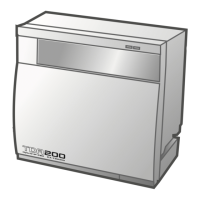
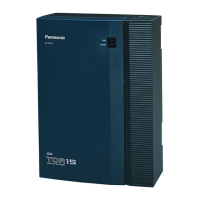
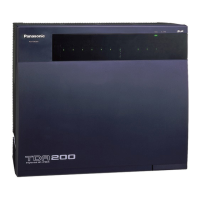

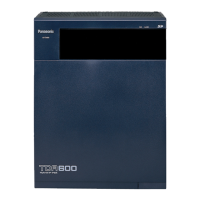
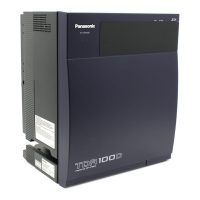

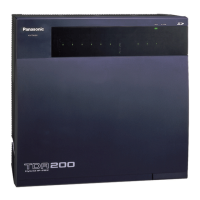
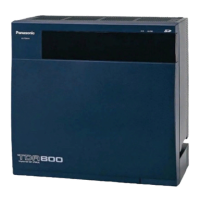
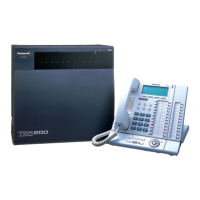
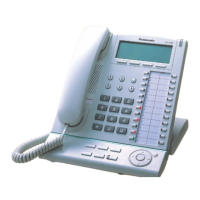
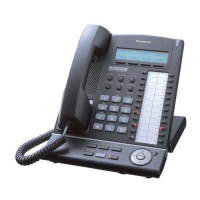
